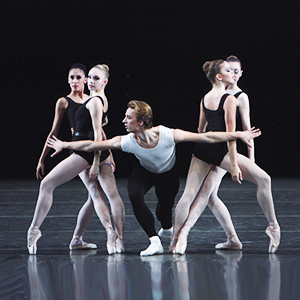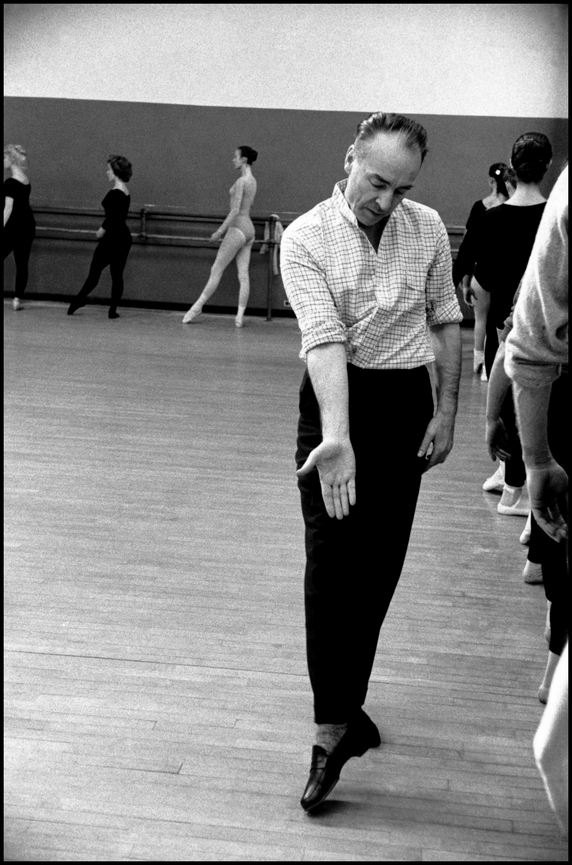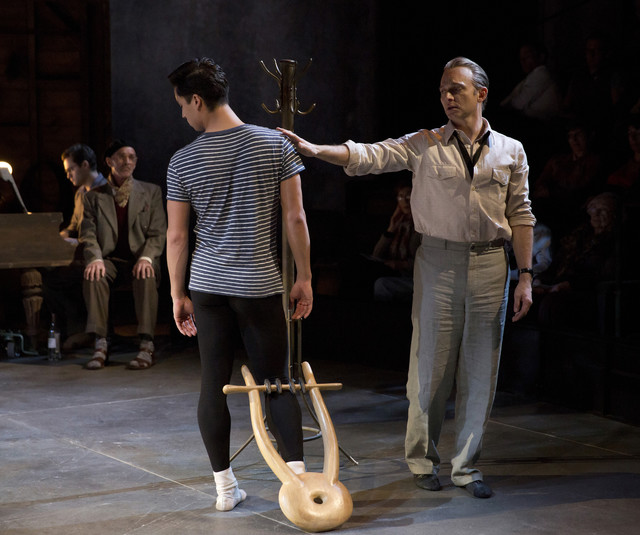 When Mrs. T and I went to see Francis Poulenc’s Dialogues of the Carmelites at the Metropolitan Opera last week, the program contained a New York City Ballet ad that was illustrated by a still photograph of the finale from George Balanchine’s The Four Temperaments, a ballet choreographed in 1946 to a score that Balanchine had commissioned six years earlier from Paul Hindemith. No sooner did my eye fall on the page than my mind filled with memories. I think that The Four Ts (as it is known to dancers and dance buffs) is the greatest of all ballets, and one of the greatest works of art of any kind, in any genre. I’ve seen it more often than any other ballet, and I’ve never done so without seeing new things in it.
When Mrs. T and I went to see Francis Poulenc’s Dialogues of the Carmelites at the Metropolitan Opera last week, the program contained a New York City Ballet ad that was illustrated by a still photograph of the finale from George Balanchine’s The Four Temperaments, a ballet choreographed in 1946 to a score that Balanchine had commissioned six years earlier from Paul Hindemith. No sooner did my eye fall on the page than my mind filled with memories. I think that The Four Ts (as it is known to dancers and dance buffs) is the greatest of all ballets, and one of the greatest works of art of any kind, in any genre. I’ve seen it more often than any other ballet, and I’ve never done so without seeing new things in it.
I love what Jerome Robbins said about the coda of The Four Temperaments: “At the end, where there are those great soaring lifts, I always feel as if I am watching some momentous departure–like interplanetary travellers taking their leave of the world.” This is what I wrote about the same moment in All in the Dances, my Balanchine biography: “To me, it is as if I have beheld the working out of a fearsomely complex equation whose triumphant solution causes the universe to explode into being.”
 If seeing a ballet can change your life, then The Four Temperaments changed mine. In the fall of 1987 I saw a PBS documentary about Balanchine that contained excerpts from several of his ballets, including a lengthy sequence from “Melancholic,” the second section of The Four Temperaments. I was so fascinated by it–as I had already been fascinated by what Arlene Croce wrote about Balanchine in her New Yorker dance reviews–that I resolved to see for myself what his works looked like in the theater.
If seeing a ballet can change your life, then The Four Temperaments changed mine. In the fall of 1987 I saw a PBS documentary about Balanchine that contained excerpts from several of his ballets, including a lengthy sequence from “Melancholic,” the second section of The Four Temperaments. I was so fascinated by it–as I had already been fascinated by what Arlene Croce wrote about Balanchine in her New Yorker dance reviews–that I resolved to see for myself what his works looked like in the theater.
What followed was an instantaneous conversion: I bought a cheap seat for a New York City Ballet performance a few weeks later, and before the year was out, I was hanging out with dance critics and writing about dance for the late, lamented New Dance Review. Who would have thought that seventeen years later, I would write a Balanchine biography? Life is full of unimaginable surprises.
New York City Ballet taped a performance of The Four Temperaments for PBS in 1977, and it has since been released on home video. But Smalltown, U.S.A., was far beyond the reach of public television in 1977, and so I had to wait another decade before discovering Balanchine. I sometimes wonder what my life would have been like had I seen The Four Ts on TV when I was eleven years old.
 Mr. B, as his dancers called him, has been on my mind ever since I reviewed Richard Nelson’s Nikolai and the Others, in which Michael Cerveris, one of my favorite actors, plays the choreographer. I had various problems with the script, but none with Cerveris, and watching him on stage filled me with an overwhelming desire to see Balanchine’s choreography in the theater again.
Mr. B, as his dancers called him, has been on my mind ever since I reviewed Richard Nelson’s Nikolai and the Others, in which Michael Cerveris, one of my favorite actors, plays the choreographer. I had various problems with the script, but none with Cerveris, and watching him on stage filled me with an overwhelming desire to see Balanchine’s choreography in the theater again.
Mrs. T, sad to say, has seen next to no Balanchine–we met after my duties as a drama critic made it difficult for me to attend dance performances–and so I checked the NYCB calendar and saw that the company will be dancing three of the best ones, Concerto Barocco, Stravinsky Violin Concerto, and Stars and Stripes on June 9. We’ll be there.
Would that The Four Ts were on the bill, but this program will do quite nicely, especially since Barocco was the first dance that I saw on that fateful night in 1987 when I made Mr. B’s acquaintance. It’ll be nice to see it again, and nicer still to introduce it to Mrs. T. All pleasures are better when they’re shared.
